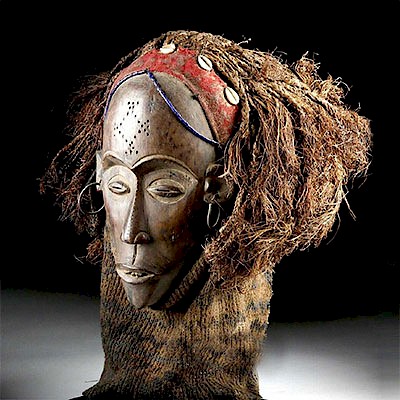Exhibited 19th C. Russian Icon - Standing St. Matthew
Lot 127c
About Seller
Artemis Gallery
686 S Taylor Ave, Ste 106
Louisville, CO 80027
United States
Selling antiquities, ancient and ethnographic art online since 1993, Artemis Gallery specializes in Classical Antiquities (Egyptian, Greek, Roman, Near Eastern), Asian, Pre-Columbian, African / Tribal / Oceanographic art. Our extensive inventory includes pottery, stone, metal, wood, glass and textil...Read more
Estimate:
$4,000 - $6,000
Absentee vs Live bid
Two ways to bid:
- Leave a max absentee bid and the platform will bid on your behalf up to your maximum bid during the live auction.
- Bid live during the auction and your bids will be submitted real-time to the auctioneer.
Bid Increments
| Price | Bid Increment |
|---|---|
| $0 | $25 |
| $300 | $50 |
| $1,000 | $100 |
| $2,000 | $250 |
| $5,000 | $500 |
| $10,000 | $1,000 |
| $20,000 | $2,500 |
| $50,000 | $5,000 |
| $100,000 | $10,000 |
| $200,000 | $20,000 |
About Auction
By Artemis Gallery
Apr 4, 2019
Set Reminder
2019-04-04 10:00:00
2019-04-04 10:00:00
America/New_York
Bidsquare
Bidsquare : Ancient / Ethnographic From Around The World
https://www.bidsquare.com/auctions/artemis-gallery/ancient-ethnographic-from-around-the-world-4003
Ancient art from Egypt, Greece, Italy and the Near East, as well as Asian, Pre-Columbian, Native American, African / Tribal / Oceanic, Spanish Colonial, Russian Icons, Fine art, much more! All categories, all price ranges... all legally acquired and guaranteed to be as described or your money back Artemis Gallery info@artemisgallery.com
Ancient art from Egypt, Greece, Italy and the Near East, as well as Asian, Pre-Columbian, Native American, African / Tribal / Oceanic, Spanish Colonial, Russian Icons, Fine art, much more! All categories, all price ranges... all legally acquired and guaranteed to be as described or your money back Artemis Gallery info@artemisgallery.com
- Lot Description
Russia, ca. late 19th century CE. A grand icon delineated in egg tempera and gilt on wood, depicting Saint Matthew the Evangelist in full view writing his Gospel. The arched form and large size suggests it would have been part of an ensemble of four evangelists featured on an iconostasis. The contrapposto stance, heavily modeled features, and presence of shadows and chiaroscuro demonstrate the influence of Western art traditions, especially those of the Renaissance. The relatively flat gold leaf background and Russian strapwork border make for a rich contrast. Size: 17.5" W x 28.25" H (44.4 cm x 71.8 cm)
The writings of Matthew are typically shown to be inspired by an angel, or after the 14th century, by Sophia Wisdom, the wingless female figure with a scepter and crowned by a double star halo. The Church Fathers assigned each evangelist one of the four living creatures of the Apocalypse, and Matthew’s symbol was the “son of man” since his writings begin with the human genealogy of Christ. According to Irenaeus of Lyon, “The Word of God made its home among men and became the Son of Man to accustom man to understanding God, and to accustom God to making His home among men.” Matthew became one of the twelve apostles (known as Levi) as well as an evangelist. He held the distinction of being the first to write a Gospel, and while in Palestine, he first wrote his Gospel in Hebrew.
Exhibited in "Windows Into Heaven: Russian Icons from the Lilly and Francis Robicsek Collection of Religious Art" at the Mint Museum of Art, Charlotte, North Carolina (December 20, 2003 through February 22, 2004) and the North Carolina Museum of History (October 4, 2013 through March 5, 2014) which presented highlights of one of the world's great artistic traditions through an extraordinary group of sixty-five 18th and 19th century Russian icons on loan from the private collection of Lilly and Francis Robicsek.
Icons (icon means "image" in Greek) are sacred objects within the Eastern Orthodox Christian tradition. Found in homes as well as churches, these painted images depict holy persons and saints as well as illustrate scenes from the Scriptures. Icons are not worshiped, but are instead venerated for their ability to focus the power of an individual's prayer to God. As such they are truly "windows into heaven."
The “Windows Into Heaven” exhibition profiled a magnificent chapter of Russian artistry, the embrace of the Russian Orthodox faith of religious icons during the Romanov centuries. The Russian religious faith was an offshoot of Byzantine Christianity, which in 1054 parted ways from Roman Catholicism. Icons were and continue to be religious images created for veneration. As a focus for prayers and meditation for believers, icons serve as “windows into heaven.”
Provenance: Ex-Francis & Lilly Robicsek Collection, Charlotte, NC, part of the Museum Exhibition, Windows into Heaven - Russian Icons from the Lilly and Francis Robicsek Collection of Religious Art, North Carolina Museum of History, Raleigh, NC.
All items legal to buy/sell under U.S. Statute covering cultural patrimony Code 2600, CHAPTER 14, and are guaranteed to be as described or your money back.
A Certificate of Authenticity will accompany all winning bids.
We ship worldwide and handle all shipping in-house for your convenience.
#119603Surface wear with losses, scratches, and fissures to gilt/painted surfaces as shown. Overall excellent with minimal disturbance to the imagery. Both crossbars/back slats remain, though one is loose. Suspension wire on verso.Condition
- Shipping Info
-
All shipping is handled in-house for your convenience. Your invoice from Artemis Gallery will include shipping calculation instructions. If in doubt, please inquire BEFORE bidding for estimated shipping costs for individual items.
-
- Buyer's Premium



 EUR
EUR CAD
CAD AUD
AUD GBP
GBP MXN
MXN HKD
HKD CNY
CNY MYR
MYR SEK
SEK SGD
SGD CHF
CHF THB
THB















